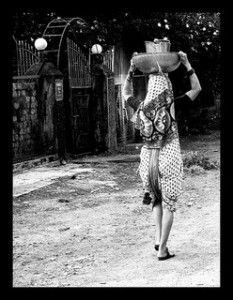by Shreya Ramachandran
In commercial Hindi cinema, the women always have to be good – and they always have to be good in the same way. They respect family, they are self-sacrificing, they are of pure character. First and foremost, they are “good girls with values”. Their being “liberated” – earning their own living, being unapologetic about their sexual choices, dressing in “revealing” ways and being comfortable with it – is backed up by explanation and justification to condone this behaviour.
Priyanka Chopra in Dostana is career-driven; the male characters in the movie find her attractive. But almost all this positive character detailing – her focus on her career, her spending her own money as she chooses, all the male attention she receives – is counteracted during an emotional scene in the movie, when she explains why she does not want male roommates – her parents would not have approved, and these small things matter to her. The reaction is everything – when she says this, the two male characters in the scene look at her differently, emotionally overwhelmed, they are now slowly falling in love with her. It is relevant that the two male characters only fall in love with her after this scene. She is worthy of love – the sort of love that leads to stability, commitment, marriage – because she is a “good girl”, despite all evidence to the contrary – the very evidence that made her liberated to begin with.
Deepika Padukone in Cocktail drinks often, dates many men, is open about her sexual choices, and is active in nightlife circles, but when her boyfriend calls off their relationship, she realises that she is not the type of woman to fit into the role of a wife; she then renounces her former wild ways, finding them meaningless and unsatisfying (“Look at me”, she despairs. “What do I have?”), and attempts to change how she dresses, how she behaves; she tries to acquire “that ada” – the quaint, feminine mystique and grace, in the hope that she will become a more respectable person, someone who will be accepted as a daughter-in-law.
In No Entry, Bipasha Basu plays a call-girl, and initially in the film she seems comfortable about her sexuality, even nonchalant about it. But it is revealed later that she has a husband, and he has been in a coma for many months, and is hospitalised on life-support. This is the reason she is so keen to earn as much as she can: to pay the medical bills. Her choice of career is to sustain her life as a good wife, nothing more.
Female characters are always designed to conform to certain value systems and behaviours, even if it may appear that they are designed differently. Showcasing independence, “modernity”, liberation, showing women deciding their lives on their own terms and making their own choices, is just a superficial way for the female characters to step out of the framework; justifying this behaviour with desperate, detailed proof that they are actually “good girls” brings them right back into this framework.
It is lazy writing to depict any character according to an established trope rather than as an original, unique, clearly-defined character, whether this character is female or male. And when you consider these characters’ gender, when you consider these characters’ femaleness, when you realise the sort of expectations charted out for them – what is good, what is bad, what is accepted by the writing in films and what is punished, however subtly – then it becomes clear that commercial Hindi cinema is holding onto a fast-fading, obsolete idea of what women should be. And bearing in mind that many religious groups, orthodox sections of society and people holding onto righteous ideas are already telling women how they are expected to dress and behave, what their domestic roles and social roles are, we do not need films reinforcing the same.
We expect to find in commercial Hindi films what we find in all forms of storytelling – a powerful redemption that allows for stories to be more complete, more satisfying, than they are in real life. The grand scale of emotion in these films allows us release for our own triumphs and tragedies, which we couldn’t properly celebrate or face in real life.
Filmmakers too, make these films to escape real life and create a world of space, freedom, and childish, naïve, elegantly crafted imagination; a world of destroying villains, saving entire towns, transcending distance to find love, waiting for years and always being rewarded; where problems are always fixed that can’t be fixed in real life; a world that always has time to allow for vengeance and justice and reunion and love; a world where poetic justice is found in three hours.
So why do filmmakers put the same restrictions in films that they are trying to escape to begin with?
A restricted world where “correct type of behaviour” is dictated and enforced is not the world the audience looks for or that filmmakers are hoping to create. As long as Hindi films are telling this story, they are defeating their own purpose.
Shreya Ramachandran is a 19-year-old writer, student and world traveller from Madras.
Pic: http://www.flickr.com/photos/ignoranthandle/






